With the pre-christmas release of the Microsoft OS/2 betas 1.00, 1.01, 1.02, 1.03 & 1.05 on archive.org, and helping Ncommander with an upcoming video, it seemed like a good place to start, not with OS/2 but rather with MS-DOS 4.0.
From the book INSIDE OS/2 ( ISBN 1-55615-117-9 )
Microsoft started work on a multitasking version of MS-DOS in January 1983. At the time, it was internally called MS-DOS version 3.0. When a new version of the single-tasking MS-DOS was shipped under the name MS-DOS version 3.0, the multitasking version was renamed, internally, to MS-DOS version 4.0. A version of this product–a multitasking, real-mode only MS-DOS–was shipped as MS-DOS version 4.0. Because MS-DOS version 4.0 runs only in real mode, it can run on 8088 and 8086 machines as well as on 80286 machines. The limitations of the real mode environment make MS-DOS version 4.0 a specialized product. Although MS-DOS version 4.0 supports full preemptive multitasking, system memory is limited to the 640 KB available in real mode, with no swapping.2 This means that all processes have to fit into the single 640 KB memory area. Only one MS-DOS version 3.x compatible real mode application can be run; the other processes must be special MS-DOS version 4.0 processes that understand their environment and cooperate with the operating system to coexist peacefully with the single MS-DOS version 3.x real mode application.
Because of these restrictions, MS-DOS version 4.0 was not intended for general release, but as a platform for specific OEMs to support extended PC architectures. For example, a powerful telephone management system could be built into a PC by using special MS-DOS version 4.0 background processes to control the telephone equipment. The resulting machine could then be marketed as a “compatible MS-DOS 3 PC with a built-in superphone.” Although MS-DOS version 4.0 was released as a special OEM product, the project–now called MS-DOS version 5.0–continued. The goal was to take advantage of the protected mode of the 80286 to provide full general purpose multitasking without the limitations–as seen in MS-DOS version 4.0–of a real-mode only environment. Soon, Microsoft and IBM signed a Joint Development Agreement that provided for the design and development of MS-DOS version 5.0 (now called CP/DOS). The agreement is complex, but it basically provides for joint development and then subsequent joint ownership, with both companies holding full rights to the resulting product.
As the project neared completion, the marketing staffs looked at CP/DOS, nee DOS 5, nee DOS 4, nee DOS 3, and decided that it needed…you guessed it…a name change. As a result, the remainder of this book will discuss the design and function of an operating system called OS/2.
– Inside OS/2.
Although MS-DOS 4.00M disk images have been floating around for quite some time, either a 2 360k disk set, or a single 720k disk image, I don’t think anyone (including me) really tore into it that much. It does have the ability to freeze DOS 3 programs, giving the illusion of running more than one. The session manager is pretty sparse but hitting left alt twice will pop it up giving you the ability to toggle through programs with ease.
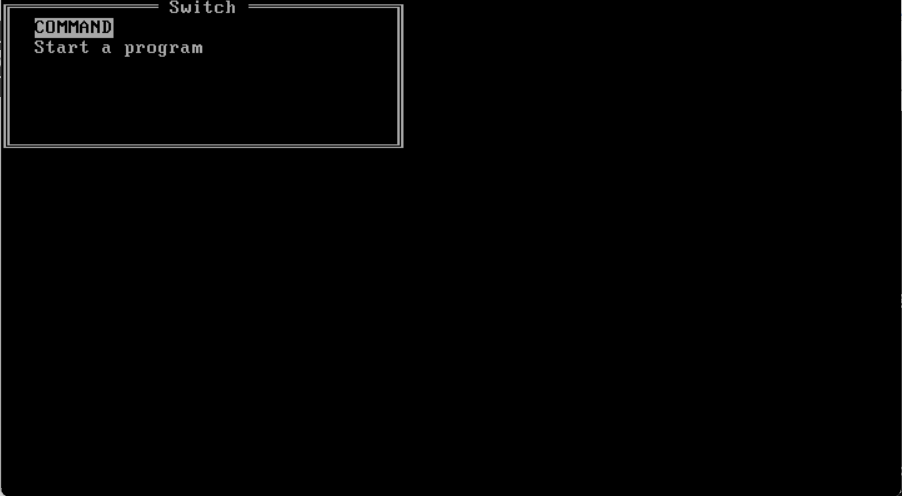
There is a FDISK, FORMAT & SYS command making it straight forward to setup a hard disk, and copy the files over, I didn’t see any installer.
there is a PS command to show running processes. Also there is a DOSSIZE to show the memory partitioning and how much is available. Although there is a SWAPPER program I’ve been unable to get it to actually fun.
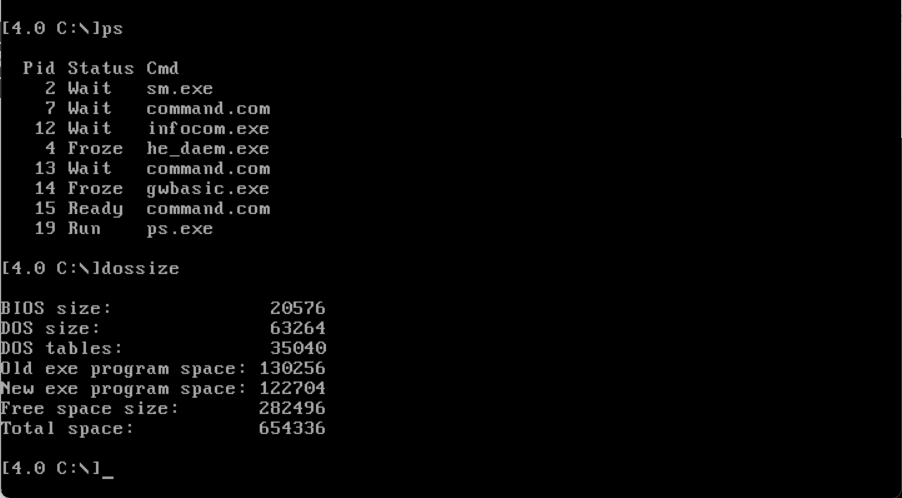
Another interesting thing if you run the unix ‘strings’ command against all the EXE’s you’ll find the string:
C Library - (C)Copyright Microsoft Corp 1985Implying that not only was DOS 4.00M a ‘new’ DOS, but it was also written in C. No doubt this contributed to a larger file size than DOS 3, however it would also give that holy grail of portability, at least to new CPU modes. Also many files have the name of the source files baked in such as:
@(#)append.c 1.1 85/10/09
@(#)assign.c 6.1 85/10/23
@(#)attrib.c 6.1 85/10/24
@(#)fdisk.c 1.1 85/10/09
@(#)fddata.c 1.1 85/10/09
@(#)fdlow.c 1.1 85/10/09
@(#)fdsub.c 1.1 85/10/09
@(#)joinsbst.c 6.3 85/11/08
@(#)sysvar.c 6.2 85/11/08
@(#)cds.c 6.2 85/11/08
@(#)dpb.c 6.1 85/11/08
@(#)label.c 6.1 85/10/24
@(#)newdef.y 6.2 85/10/14
@(#)ms4bnr.c 1.1 85/10/15
@(#)mode.c 6.2 85/10/24
@(#)getkey.c 6.1 85/10/25
@(#)pifmes.c 6.1 85/10/25
@(#)advpscrn.c 6.1 85/10/25
@(#)advescrn.c 6.1 85/10/25
@(#)usrscrn.c 6.1 85/10/25
@(#)rangers.c 6.1 85/10/25Okay so far, so good. But we’ve all seen this before, and scratched this OS about this far, because what else can you do? It’s not like there is any dev tools to do anything fun!
Well the tool hidden in plain sight is LINK4, which in retrospect is specific for MS-DOS 4.00M.
Microsoft (R) 8086 Object Linker Version 4.01
Copyright (C) Microsoft Corp 1984, 1985. All rights reserved.
Object Modules [.OBJ]:There is no SDK for MS-DOS 4.00M, but they were kind enough to leave the linker in place. A quick check of the Windows 1.01 SDK shows that it also includes LINK4:
Microsoft 8086 Object Linker
Version 4.00 (C) Copyright Microsoft Corp 1984, 1985
Object Modules [.OBJ]:It appears that if the dates and versions are to be trusted they are of the same vintage, but the Windows linker is older, and that they both output to a NE or New Executable. So to start the experiment I created a simple hello world exe from a simple:
void main(){
printf("Hello from MSC 3\n");
}To compile this I used Microsoft C 3.0 (more on why later), and used LINK4 to create an EXE:
C:\dos\msc3>cl /c hello.c
Microsoft C Compiler Version 3.00
(C)Copyright Microsoft Corp 1984 1985
hello.c
C:\dos\msc3>msdos dos4m\link4 hello.OBJ
Microsoft (R) 8086 Object Linker Version 4.01
Copyright (C) Microsoft Corp 1984, 1985. All rights reserved.
Run File [HELLO.EXE]:
List File [NUL.MAP]:
Libraries [.LIB]:
Definitions File [NUL.DEF]Okay, everything looks fine so far. Attempting to run this under MS-DOS just results in the error:
Program too big to fit into memoryWell now that’s odd. Checking the EXE with the Linux ‘file’ command reveals:
file HELLO.EXE
HELLO.EXE: MS-DOS executable, NE (unknown OS 0) (EXE)So obviously it’s a NE, but it is an older/unknown version to the file map database. There is no stub so I suppose that is why MS-DOS is getting confused.
Now let’s try MS-DOS 4.00M
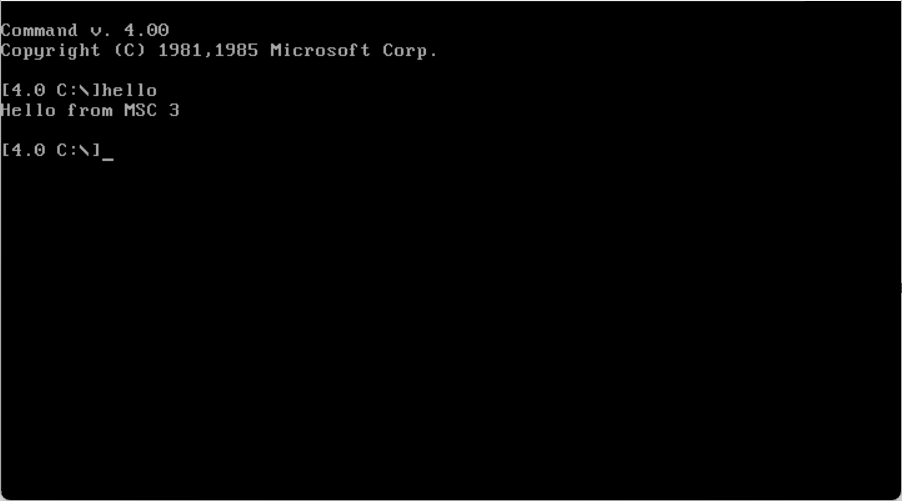
Well now isn’t that interesting?!
Excited with the ability to create special MS-DOS 4.00M programs, I get my favorite vintage ’87 Infocom interpreter, InfoTaskForce 87, and get it building on MSC 3.0. However instead of using the MS-DOS 4.00M linker, I thought I should try to use the Windows 1.01 linker and libraries for the exe:
C:\dos\msc3\infocom>msdos ..\win101sdk\bin\LINK4.EXE @infocom.win.lnk
Microsoft 8086 Object Linker
Version 4.00 (C) Copyright Microsoft Corp 1984, 1985
Object Modules [.OBJ]: FILE.OBJ FUNCS.OBJ INFOCOM.OBJ INIT.OBJ INPUT.OBJ +
Object Modules [.OBJ]: INTERP.OBJ IO.OBJ JUMP.OBJ OBJECT.OBJ OPTIONS.OBJ PAGE.OBJ +
Object Modules [.OBJ]: PRINT.OBJ PROPERTY.OBJ SUPPORT.OBJ VARIABLE.OBJ TERM.OBJ
Run File [FILE.EXE]: INFOCOM.EXE/ALIGN:16
List File [NUL.MAP]: INFOCOM.MAP
Libraries [.LIB]: MWLIBFP MWLIBC/NOD
Definitions File [NUL.DEF] INFOW.DEF;And for those interested this is my .DEF file:
NAME Infocom
DESCRIPTION 'Infocom 87 interpreter for Planetfall(83)'
DATA MULTIPLE
HEAPSIZE 1024 ; Must be non-zero to use Local memory manager
STACKSIZE 4096 ; Must be non-zero for SS == DS
; suggest 4k as minimum stacksize
SEGMENTS
_INIT PRELOAD MOVEABLE DISCARDABLEOne thing to save you the horror is that between MS-DOS 2 & 3 the way command line arguments changed. I forget the details but no matter what I tried I was unable to parse the CLI or the environment in this setup. I suppose if I had documentation of the product there would be some hint as to what tools or setup to use. Instead, I took the easy way and hard coded to load Planetfall.
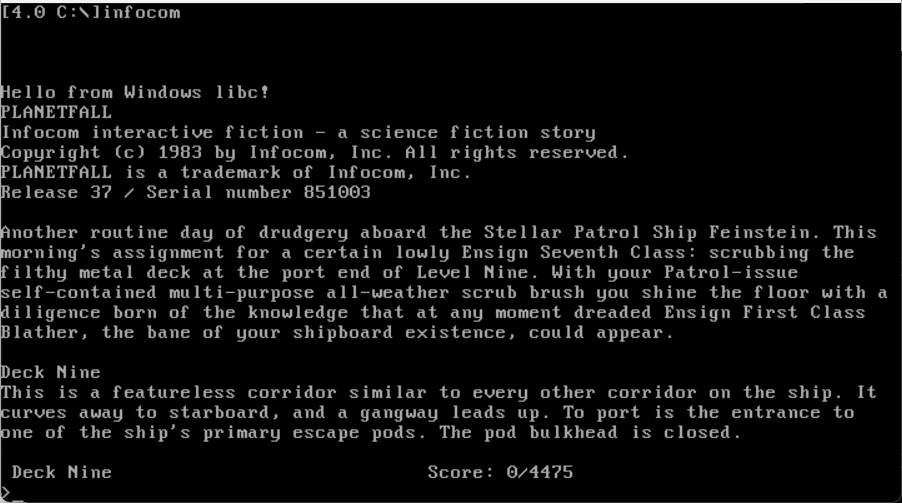
Unfortunately, this success would prove to be the exception to the rule. I took trek, converted it to K&R C, as Microsoft C 3.00 from 1985 is well. old, and sadly it just won’t run. Likewise, I took Hack 1.03 and although it runs on MS-DOS it will not run on MS-DOS 4.00M. I am sure there is some fundamental reason why it’s not working, and probably tied to creating a proper DEF file. I’m sure it was all written down somewhere but I don’t know. And yes I tried specifying either floating point emulation via library or inline, and it made no difference.
Looking at OS/2 1.00
Loading up the infamous $3,000 OS/2 1.00 beta, and hitting ctrl+escape you are greeted with session manager!
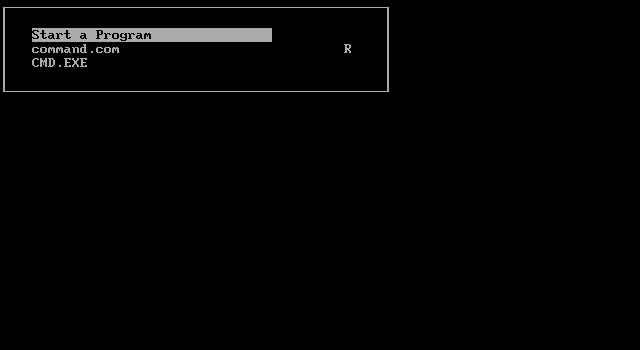
Notice the R for real-mode. With the obvious implication that everything else is protected mode. Going one step further on the excellent site pcjs.org there is OS/2 betas SIZZLE and although there is no OS/2 development bits on there, the directory DOS3TOOL reveals that the C compiler for this era for at least MS-DOS is MSC 3.0. Also included is our friend LINK4.
I create a simple def file that contains the single word ‘PROTMODE’ which should give me my OS/2 binary.
So let’s run that through hello world:
msdos sizzle\DOS3TOOL\link4 hello.OBJ,hello,,,hello.def;
Microsoft (R) Segmented-Executable Linker Version 5.00.21
Copyright (C) Microsoft Corp 1984, 1985, 1986. All rights reserved.
C:\dos\msc3>However attempting to run this just crashes amazingly.
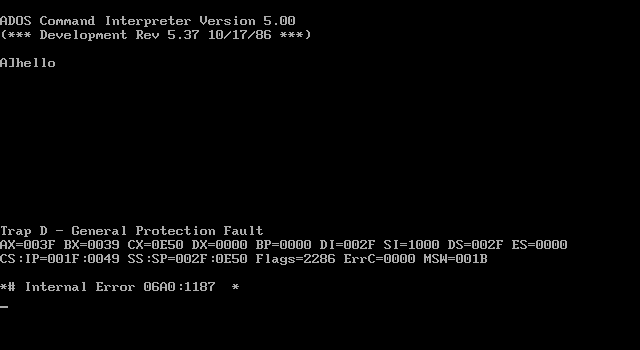
No doubt it’s because the real-mode libc is using interrupt 21 calls, which OS/2 sure wouldn’t like. I’m pretty sure it requires an OS/2 libc that uses DOSCALLS.DLL to function, which I just don’t have any pre-release versions, nor any libc source code to really make it possible. And attempting to port one to OS/2 pre-releases just doesn’t seem so worth the time.
So for the heck of it I point the LIB variable to the OS/2 1.00 SDK’s libs and re-run the link:
C:\dos\msc3>msdos sizzle\DOS3TOOL\link4 hello.OBJ,hello.exe,hello.map,C:box0\x\MSC\LIB\slibc5.lib box0\x\LIB\DOSCALLS.LIB,hello.def;
Microsoft (R) Segmented-Executable Linker Version 5.00.21
Copyright (C) Microsoft Corp 1984, 1985, 1986. All rights reserved.By default it’s trying to link in EM.LIB, SLIBFP.LIB, SLIBC.LIB. Trying to add them all in the command line link just hangs LINK4 maybe a response file is better suited. Anyways:
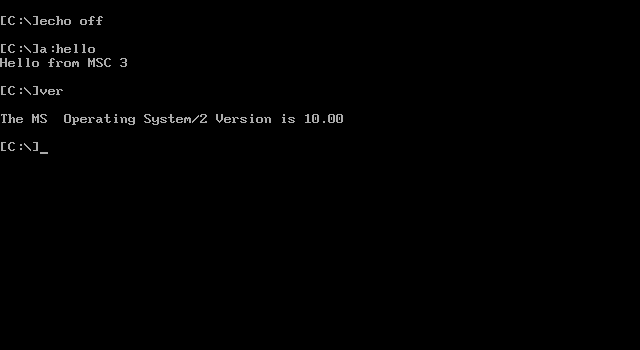
It does run on OS/2 1.00, which I guess isn’t surprising as the LINK4 & libraries are from/for this version.
As an interesting note, OS/2 links against doscalls library/DLL to interface to the OS. While MS-DOS 4.00M doesn’t have a seperate DLL, rather it’s baked into IBMDOS.COM
DOSCALLS
ALLOCSEG
REALLOCSEG
FREESEG
LOCKSEG
UNLOCKSEG
GETSEGSIZE
GETDSHANDLE
CRITENTER
CRITLEAVE
FCRITENTER
FCRITLEAVE
PBLOCK
PRUN
SUBSCREEN
GETPIDS
DOSDISCARDCODE
DOSGETHANDLE
DOSHANDLEJUMPNoticeably absent is file I/O, No doubt allowing programs to use the standard int21 interface to the kernel for file I/O. No doubt this is in its primordial state, as the OS was going to evolve a bit more until it became OS/2. Unfortunately I have no idea how to link or call into this. Without any SDK it’s impossible to say. And even then is developing for a real mode OS worth the effort?
So what have we learned? LINK4, aka the MS-DOS 4.00M Linker, probably should have been called LINKNE for the NE format. Also there is references to it having it’s own virtual memory paging system, and being able to link larger EXE’s than the traditional link command. Sadly I was unable to get any non trivial programs running. I don’t think it was a memory model thing, although the C compiler has issues with InfoTaskForce and the large memory model for some reason, but small & medium work fine. I’d like to think that DOS 4.00M could support massive EXE’s much like Windows 1.01, however despite being from the same company and using the same tools, the memory manager for DOS 4.00M & Windows is fundamentally different.
With all these exiting OS/2 betas now available I’ll have to take some more time to explore them in more detail.
But until then I thought this genesis of DOS 4.00M was worth the look.

I’m surprised when you say that “the memory manager for DOS 4.00M & Windows is fundamentally different.” I thought that Microsoft insiders like Larry Osterman have said that Windows 1’s Kernal basically used the Multitasking DOS memory manager unchanged. What differences did you notice between Windows’ and DOS 4M’s?
Interesting, and it has the square bracketed command prompt already, that would be in cmd.exe in all the later OS/2s.
I wonder if the multitasking / freezing code has anything in common with the much late dosshell.exe in DOS 5, or did they write that completely from scratch ?